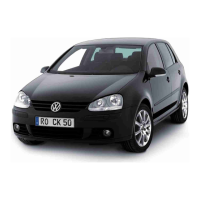Swallowing a 20 mm diameter battery or other
button cell batteries can cause serious or even
fatal injuries in a very short time.
•
Keep the vehicle key and battery-operated key
fobs out of the reach of children.
•
If you suspect that someone has swallowed a
battery, seek medical assistance immediately.
Changing the button battery
(
vehicle
key
with stylus)
Emergency key
Fig. 55 Vehicle key: unlocking the emergency key.
Move the lock in the direction of the arrow
Pull out the emergency key in the direction of
the arrow.
The vehicle key includes an emergency key
→ fig. 55
to unlock and lock manually-
•
If the battery is incorrectly replaced, the key
may be damaged.
•
The use of unsuitable batteries can damage the
key. Therefore, always replace the exhausted
battery with a new one of the same voltage, size
and specification.
•
When installing the battery, observe polarity.
Batteries of the type used in the remote
control of the vehicle key can be used in
the remote control of the vehicle key.
contain perchlorate. This may require special
handling. Please observe all legal regulations
regarding the handling and disposal of these
batteries. We recommend that you have this work
carried out by a Volkswagen dealer or specialist
workshop.
The vehicle. Possible
operations:
—
Unlocking and locking the glove box
—
Manually unlocking and locking the vehicle
→ p. 65
—
Activating and deactivating the child lock
→ p. 72
Volkswagen recommends that you have the tyre
replaced by one of your Volkswagen dealers or a
specialist workshop → .
—
Unfold the key bit.
—
Detach the cover by levering it off → .
Changing the button cell battery
Fig. 56 Vehicle key: Open the battery compartment
cover.
—
Remove the battery from the battery compartment by doing the following
lever 2 .
—
Insert a new button cell battery into the
battery compartment → .
—
Press the cover onto the housing 1 .
—
Dispose of the exhausted battery in an
environmentally friendly manner.

